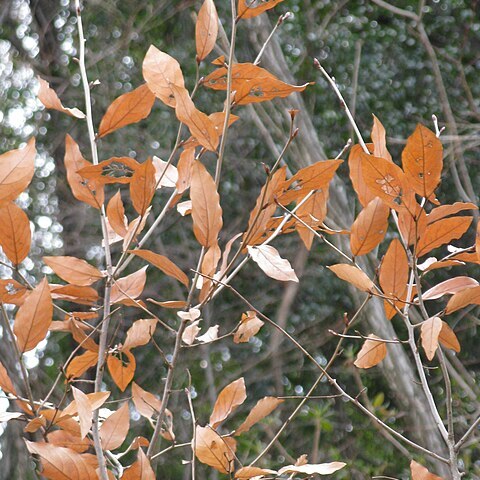Deciduous shrubs or trees, up to 8 m tall. Bark smooth, gray or gray-white. Young branchlets white-yellow, brown pubescent, later glabrate. Winter buds (mixed bud) long corniform-conical, ca. 1.5 cm × 4 mm; bud scales red on exserted parts. Leaves alternate; leaf blade broadly elliptic, elliptic, obovate, or narrowly obovate, 4-9 × 2-4(-6) cm, papery, greenish and white pubescent abaxially, green adaxially, pinninerved, lateral veins (4 or)5 or 6 pairs. Umbels axillary; involucral bracts inserted in mixed bud, green, membranous, 3-8-flowered inside. Male flowers: pedicels ca. 1.2 cm, densely white pubescent; tepals yellow, elliptic, ca. 2.2 mm, nearly equal in size in 1st and 2nd whorls, pubescent on dorsal keels; stamens 9, equal in length; filaments glabrous, 2-glandular at base in 3rd whorl; glands broadly reniform, cornute, stipe base and filament base coadnate, sometimes a small gland at filament in 2nd whorl; reduced pistil small, elliptic, ca. 1 mm, mucronate at apex. Female flowers: pedicels 3-6 mm, black-brown at maturity; tepals yellow, elliptic or obovate, equal in length in outer and inner whorl, ca. 2 mm, laxly pubescent on dorsal keel of outer surface or rarely pubescent at base; reduced stamens ca. 1 mm, fasciated, 2-glandular at filament base in 3rd whorl; glands ca. 0.5 mm, irregularly reniform, stipitate, stipe and below middle of reduced stamens coadnate; ovary ellipsoid, ca. 1.5 mm; style ca. 0.3 mm; stigma disciform. Fruit stipes 1-1.5 cm. Fl. Mar-Apr, fr. Jul-Aug.
More
A shrub or small tree. It grows 8 m tall. The bark is smooth and grey to white. The young branches are white to yellow with brown hairs. The leaves are alternate and the leaf blade is oval and 4-9 cm long by 2-4 cm wide. There are white hairs underneath. Male and female flowers are separate.


